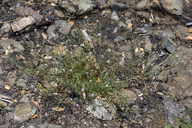notes NOTE: Larger more detailed versions of this photo may be examined at this Flickr link. Also, you may comment on the ID or other aspects this post at this associated Flickr URL.
This plant was part of a population growing mostly in partial shade under burnt or badly charred oaks and bay trees, photographed here during the spring following the Morgan Fire of September, 2013.
It keyed clearly in Ertter & Bowerman's flora for Mt Diablo to species Gilia achilleifolia. But getting this plant to subspecies in that key was ambiguous at the following couplet:
''Flowers mostly solitary on slender pedicels; inflorescense pubescence sparse......G. achilleifolia ssp. multicaulis'' vs. ''Inflorescense of many-flowered clusters; inflorescence pubescence of dense, white, crisped hairs''....[leading to]...G. achilleifolia ssp. achilleifolia
The above key couplet is ambiguous here because this plant has both ''flowers mostly solitary on slender pedicels'' AND ''inflorescence pubescence of dense, white, crisped hairs''. However, compare the images of the plant here with those of a very nearby plant in this post, which was growing at the edge of the shade of the burnt trees.
Regarding determination to subspecies here, note that the paper cited below indicated that there are two relatively coherent variants within G. achilleifolia: a ''sun'' variant, and a ''shade'' variant.
Grant, Verne (1954). 'Genetic and taxonomic studies in Gilia. IV. Gilia achilleaefolia', El Aliso 3: 1–18.
Field observations discussed in that paper indicated plants growing in sunny situations were taller, with glomerate inflorescences of many (larger) flowers on short pedicels (1-2mm); while plants growing in shady situations were shorter, with solitary (smaller) flowers on long (15-20mm) slender pedicels. Moreover, seeds collected and grown in experimental gardens from both of these variants exhibited characters like the sun variant when grown in full sun, and like the the shade variants when grown in shade...so the associated morphological characters were presumed to be environmentally induced. In summarizing the variation in G. achilleifolia overall, Grant stated that:
''There is complete intergradation between the robust large-flowered capitate forms of sunny places (exemplified by the Douglas collection of Gilia achilleaefolia), through spreading small-flowered types growing in sunlight (exemplified by the Douglas specimen of Gilia multicaulis), to weak plants with a few small flowers on elongated pedicels in shady woods (the equivalents of Gilia peduncularis Eastw.). These various types have no well-marked geographical segregation.''
Grant's circumscription placed the formerly named G. multicaulis Benth. and G. peduncularis Eastw. in synonymy under subspecies G. achilleifolia ssp. multicaulis, while the former G. achilleifolia became the nominal subspecies G. achilleifolia ssp. achilleifolia. So, from the above quote, subspecies multicaulis presumably contains both the ''shade'' variants and the low-growing, small-flowered ''sun'' variants; while the larger-flowered ''sun'' variants with many-flowered glomerate inflorescences presumably correspond to the nominal subspecies achilleifolia.
What puzzles me is why these are referred to as ''subspecies'' rather than varieties (or ecotypes?)...since they are not geographically isolated populations. Perhaps it was Grant's assessment that, in natural populations, the breeding system of ''sun'' variant plants principally involved outcrossing via insect pollination; whereas the ''shade variant'' plants were principally self-pollinating? I don't know whether further research after 1954 may have led to a change in the current thinking on the ''sun'' and ''shade'' variants; the different breeding systems; and the correlation to subspecies here. But I think subsequent studies and papers (e.g. by Grant and/or Schoen) may have addressed some of these issues.
It's of interest to note that the seed bank for the plants I observed here would have developed over many years under the relatively dense shade of the canopy of old oaks...although any plants near the edge of the oak's shade (or beyond the edge) may have been subject to a more ''sunny'' regime. However, in the aftermath of the fire, the plants were subjected to a more intense 'sunny' regime, due to the loss of canopy foliage. This may help account for the ambiguity in this plant vis-a-vis the distinguishing characters for the subspecies. Or, as the earlier quote indicates, the polymorphism present in this population (and most others as well, according to Grant's paper) may make the attempt to assign a subspecies here unwise.
